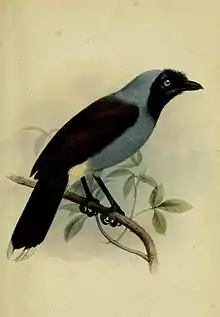Campina jay
The Campina jay (Cyanocorax hafferi) is a passerine from the genus Cyanocorax, a group of jays which occur in the Neotropics. It was first discovered in August 2002 by Mario Cohn-Haft but stayed unrecognised for two and a half years until the holotype was collected in January 2005. In 2013, this species was formally described in the Handbook of the Birds of the World. The species' epithet commemorates Dr. Jürgen Haffer, an ornithologist from Germany, best known for his Pleistocene refugia hypothesis developed in 1969. The common name campina refers to its specific habitat, a cerrado-like open savanna in the Amazon River basin in Brazil.
| Campina jay | |
|---|---|
 | |
| Scientific classification | |
| Kingdom: | Animalia |
| Phylum: | Chordata |
| Class: | Aves |
| Order: | Passeriformes |
| Family: | Corvidae |
| Genus: | Cyanocorax |
| Species: | C. hafferi |
| Binomial name | |
| Cyanocorax hafferi Cohn-Haft et al., 2013 | |
The HBW and Birdlife checklist recognizes campina jay as a separate species. The other three taxonomic authorities - Howard & Moore, EBird/Clements and the IOC - consider it to be a subspecies of azure-naped jay.[2]
Distribution
The Campina jay is endemic to the Brazilian Amazon where it is known almost entirely from within the Madeira-Purus interfluve in the state of Amazonas.
References
- BirdLife International. 2017. Cyanocorax hafferi. (amended version published in 2016) The IUCN Red List of Threatened Species 2017: e.T103728087A112425875. https://dx.doi.org/10.2305/IUCN.UK.2017-1.RLTS.T103728087A112425875.en. Downloaded on 05 November 2017.
- del Hoyo, J (Ed.) (2020). All the birds of the world. Barcelona: Lynx Edicions. p. 561. ISBN 978-84-16728-37-4.CS1 maint: extra text: authors list (link)
- Cohn-Haft, Mario; Marcelo A. Santos Junior; Alexandre M. Fernandes; Camila C. Ribas (July 2013). Josep del Hoyo; Andrew Elliott; Jordi Sargatal; David A. Christie (eds.). A new species of Cyanocorax jay from savannas of the central Amazon. Handbook of the Birds of the World. New Species. Lynx edicions. pp. 306–310. ISBN 978-84-96553-88-0.
External links
- Gill, Ferran (3 July 2013). "15 New species of birds discovered in Amazonia". Retrieved 19 August 2013.
